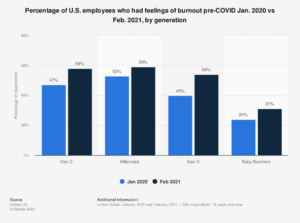In a results-oriented business, managers and leaders can sometimes spend too much time focusing on business outcomes while forgoing the well-being of their staff. This can lead to burnout, especially in part-time, hourly, and on-demand workers. This article will discuss how managers can recognize when staff is overworked and the signs of burnout to provide the appropriate support to workers who need it.
Why Is It So Difficult for Managers to Spot the Signs of Burnout?
All work involves some stress. But regardless of the industry, there are some behaviors and conditions in the workplace that contribute more to employee burnout. The problem is compounded because in a “going the extra mile” work culture, overworking can easily be confused with high productivity. Managers may not recognize burnout in an employee until it is too late—and the employee leaves.
Some common causes of burnout include:
- A toxic environment: A toxic workplace can be characterized by a lack of teamwork and cooperation. Employees usually have negative feelings towards the work and the company.
- Unclear instructions and expectations: When managers don’t communicate what is expected from the employees and there are no clear guidelines, employees can be confused and frustrated, and productivity suffers.
- Poor communication: Lines of communication need to be maintained among employees and between employees and managers.
- Being overworked and unappreciated: Managers may forget how much effort goes into a typical shift, and can fail to recognize when an employee is giving it their all. A lack of recognition will soon lead to employees feeling their efforts are not appreciated.
- Being micromanaged: Constant oversight and direction can damage an employee’s confidence and affect their performance and productivity. If the micromanaging continues, there is a high risk of employee burnout.
Every person has their limits and nobody can endure a stressful situation indefinitely. Sooner or later, people reach a breaking point. Burned out employees who cannot quit their jobs tend to get sick more often and take more leaves of absence, affecting business performance.
The Impact Burnout Can Have on Business Operations
Burnout can have serious consequences for an employee’s health. According to the WHO, burnout can lead to physical and psychological illnesses like depression, heart disease, and diabetes.
But the impact of workplace burnout can be disastrous for a business, too; especially for employers of on-demand workers, where high turnover rates are always top of mind:
- Decreased productivity: If an employee feels the work they do lacks purpose, they lose the motivation to make their maximum effort. As a result, they’re more likely to make mistakes.
- Impact on employee retention, especially among millennials and younger workers: Burned out employees look for the first opportunity to quit, especially the younger generations. Employees may also engage in quiet quitting.

- The quality of work deteriorates: When an employee is demotivated, the quality of their work suffers.
- Poor customer service: Long shifts and stressful work can cause burnout among customer service employees, which in turn decreases the quality of the service.
- Damage to reputation: When productivity and quality suffer, ultimately the company’s reputation will be affected, which can lead to loss of business.
How to Recognize the Signs of Burnout
So, how can managers recognize the signs of burnout? The most common include:
- More overtime
- Increased employee turnover
- Tense or emotional work environment
- Cynical attitude towards the job
- Lack of participation
- Increased employee absenteeism
- Decreased productivity and performance
- Negative customer feedback
How to Help Workers Suffering from Burnout
If you detect symptoms of burnout in your employees, here are some tips you can apply to help your workers:
- Make their schedules and communication easier: Not every job follows a 9–5 Monday-to-Friday schedule at the same workplace. On-demand job schedules can vary greatly. While some may enjoy this variety, they need to know whether they will work next week, which days, and which shifts, so they can plan their life outside work. Clear instructions for each assignment are also needed. Having the schedule out early and providing all relevant job details is critical for on-demand employees.
- Provide opportunities for growth: Doing the same job day in and day out can weigh on a person—especially when no one seems to notice they are capable of more. Prevent burnout by offering opportunities to develop employees’ skills and careers.
- Arrange schedules to support work-life balance: Take life events into consideration, and ask for feedback about future schedules. Using a staff management technology solution can help track changes and make a flexible schedule easier to achieve.
- Don’t give your employees more work than they can handle: This is probably the most important tip. Most work burnout starts with overworked employees. Ask your staff if they are comfortable taking on additional tasks, and pay attention to signs of overwork.
How Technology Can Help Prevent Employee Burnout
Inefficient work management can result in employee burnout. A disorderly schedule and poor staff management lead to unplanned work, mix-ups, and last-minute changes. It contributes to employees’ stress and decreases productivity and motivation.
When planning the schedule, it’s important to have at-a-glance visibility so you can see how employee’s schedules are balanced and prevent overwork. Mismanagement gives way to workplace chaos and employee dissatisfaction. Relying on manual processes can lead to errors and contribute to the problem instead of helping solve it.
Using a staff management solution can help solve most management challenges that cause burnout. Nowsta offers a complete system to hire, schedule, and manage on-demand employees. It gives you a centralized interface where you can see and manage the on-demand staff with complete visibility. The solution leverages artificial intelligence (AI) to automate scheduling, track employees’ time, and provide easy to use communication tools in real time.
In an era of businesses focused on productivity, it can be tricky for managers to identify signs of burnout among their employees. However, it is critical to do so, as burnout can have disastrous consequences for a business.
Nowsta can ease the burden of on-demand employee management by automating and simplifying scheduling and communication. Learn more about how Nowsta can be a key tool for preventing employee burnout for your business.
